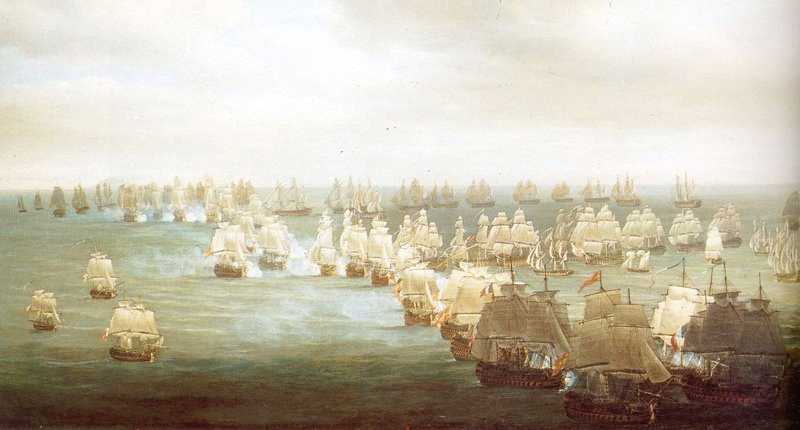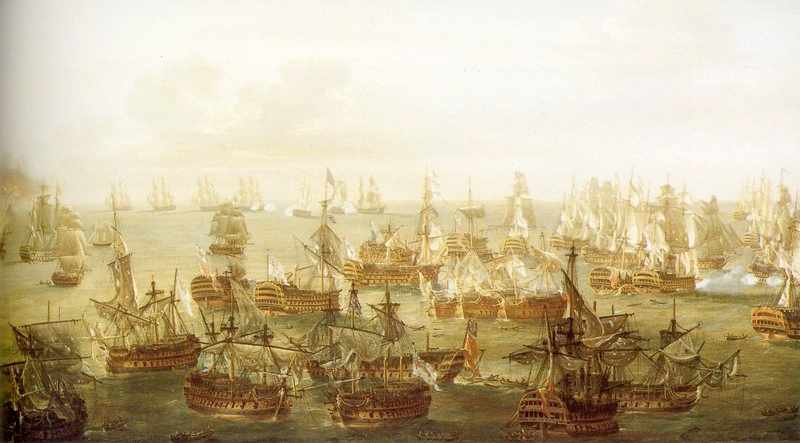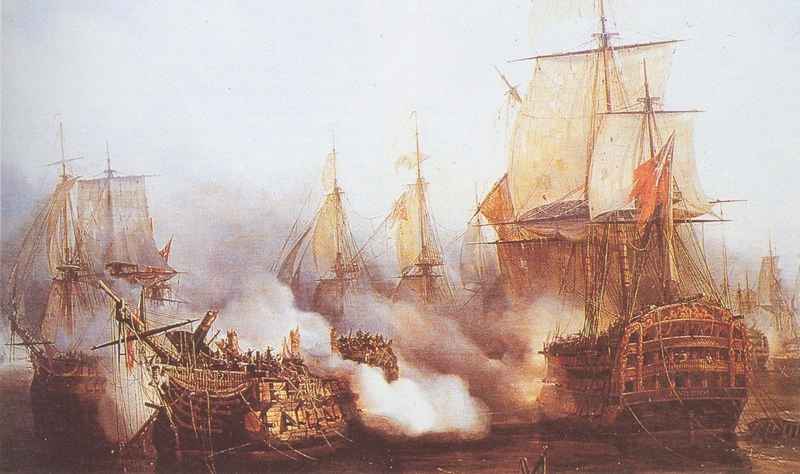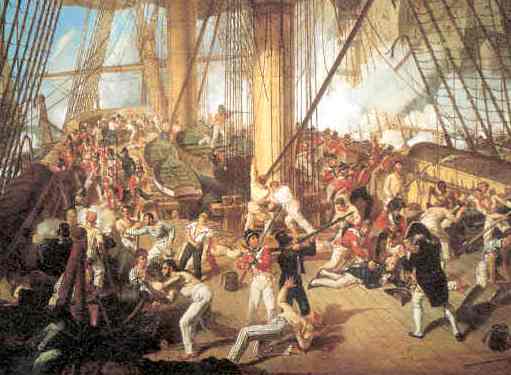|
THE BATTLE OF TRAFALGAR 1805
|
|
HOME | BIOLOGY | FILMS | GEOGRAPHY | HISTORY | INDEX | INVESTORS | MUSIC | SOLAR BOATS | SPORT |
|
GREAT LEADERSHIP
The Battle of Trafalgar, (French: la bataille de Trafalgar, Spanish: la batalla de Trafalgar) fought on 21 October 1805, was the most significant naval engagement of the Napoleonic Wars and the pivotal naval battle of the 19th century. A Royal Navy fleet of 27 ships of the line under the command of Admiral Lord Nelson destroyed a combined French and Spanish fleet consisting of 33 ships of the line west of Cape Trafalgar in southwest Spain. The Franco-Spanish lost 22 ships, the British none.
The British victory put an end to Napoleon's plans to invade Britain across the English Channel. Once the threat of invasion was removed, British troops could be used to fight on the European continent which was a major factor in Napoleon's ultimate fall. Nelson died in the battle, but became a war hero. After the battle, the Royal Navy remained unchallenged as the world's foremost naval power until the rise of Imperial Germany prior to the First World War, 100 years later.
Strategic background to the battle
In 1805 under Napoleon, the French were the dominant military power on the European continent, while the British controlled the seas. The British, during the course of the war, managed to impose a naval blockade on France. This blockade both affected French trade and had the effect of keeping the French from fully mobilizing their own naval resources. Although there were a number of occasions when French naval ships evaded the blockade, they were never able to fully exploit this or inflict a major defeat on the British. The British control of the seas also enabled them to attack French interests at home and abroad with relative ease.
When the Napoleonic war broke out in 1803, after the short lived Peace of Amiens, Napoleon Bonaparte was determined to invade Britain. To do this he had to ensure that the Royal Navy would be unable to disrupt the invasion flotilla while the invasion was in progress. This would require the French fleet to control the English Channel.
At that time, there were major French fleets in Brest in Brittany and Toulon on the Mediterranean coast. Other ports on the French Atlantic coast had smaller but not insignificant squadrons. In addition, France and Spain were now allied so the Spanish fleet based in Cádiz was also available.
Napoleon's plan was for the French and Spanish fleets in the Mediterranean and Cádiz to break through the blockade and combine in the West Indies. Then they would return and assist the fleet in Brest emerge and in combination clear the English Channel of Royal Navy ships and ensure a safe passage for the invasion barges.
Early in 1805, Admiral Lord Nelson was commanding the British fleet blockading Toulon. Unlike Cornwallis, who commanded the Channel Fleet's tight blockade of Brest, Nelson adopted a loose blockade in the hope of luring the French fleet into leaving port. Nelson hoped to then engage the French in a major battle and so too, destroy them. However, the danger of this tactic was that the French would emerge and evade Nelson's forces and so be free. This is what occurred. Admiral Pierre de Villeneuve's ships sailed when Nelson's forces were blown off their station by storms. While Nelson was searching for them in the Mediterranean, Villeneuve passed through the Straits of Gibraltar, rendezvoused with the Spanish fleet and sailed according to plan to the West Indies.
Once Nelson realised that the French had evaded him and crossed the Atlantic Ocean, he abandoned his station in the Mediterranean and pursued them. This was typical of his attitude that the leader on the spot could make the best decisions.
In the West Indies, the French fleet again evaded Nelson's forces; on one occasion, they passed close to each other but without detection by either side. The French sailed for Europe to break the blockade at Brest but after an encounter with a squadron under Admiral Sir Robert Calder which resulted in the capture of two Spanish ships, Villeneuve decided not to try and join the fleet in Brest and sailed back to Cádiz where he was blockaded by a small British squadron under Admiral Collingwood.
Nelson's forces followed the French back and joined Collingwood to enforce the blockade of Cádiz. Nelson returned to England for a short time before sailing to join Collingwood and assuming command of the blockading forces. Nelson wanted to bring the Combined Fleet to battle so most of the British fleet remained at sea out of sight of land with only a few frigates close inshore to monitor the fleet's movements.
Naval tactical background
During the 1700s naval battle tactics developed from the free-for-all melées of the 1600s where the admiral commanding a fleet had little or no control of the disposition and actions of his ships. The concept of the line of battle was developed where every ship of the line had its predetermined position in the line of battle and the fleet attempted to stay in this formation during the battle. Both admirals would attempt to form up into long lines. The two lines would then manoeuvre, sometimes for days, in an effort to close to within gunfire range often seeking the advantage of the weather gauge. Each ship was then supposed to attack its opposite number in the enemy line. This led to battles of attrition where lines of ships battered at each other until one side withdrew, at which point both would limp home for repairs.
More damage could be done when a ship could 'rake' another. Firing the length of a ship from either the bow or stern was more advantageous, because a single shot would fly down the length of the decks causing damage and death to more of the gun crews. An additional benefit was that the opponent could not return fire using their broadside cannon. However, this was more often seen in single ship actions rather than when a fleet was fighting in line.
There had been some developments of new tactics as early as 1782. After defeating the British attempt to reinforce their deployment in what would soon be the United States during the Battle of the Chesapeake, the French decided to attempt the taking of Bermuda. Facing them was a smaller fleet under George Rodney. When they met in the Battle of the Saintes on April 12 things looked excellent for the French, but a missed signal made their line split up. Rodney quickly signalled a 90 degree turn in his own line, running his ships between the French line while they continued to sail in their original directions. His ships ended up raking the French ships and soon forced six of their ships to strike their colours (lower their flags as a sign of surrender).
Nelson's Battle Plan
Nelson's plan for defeating the Combined Fleet had been discussed with his captains days before the battle. He intended to attempt to break the enemy line of battle with two or three columns in order to cut the centre and rear of the fleet from its van, and to then concentrate his forces on the ships in rear part of the line. Since the ships would be sailing downwind, it would be difficult for those in the van to sail back upwind and come to the aid of the rear. This is a similar tactic to that which Nelson had already used successfully at the Battle of Cape St. Vincent (1797), but here it was applied as a deliberate plan on a larger scale.
Battle
At Cádiz, in Spain, Admiral Pierre de Villeneuve, hearing that Napoleon had sent a replacement who was on his way to take over Villeneuve's command, the combined French and Spanish fleet finally set sail. It took two days, October 19 and October 20, for the combined fleet to clear the harbour at Cádiz, and on the morning of October 21, the British approached as the Spanish and French ships were still struggling to form up south of Cádiz in light and contrary winds.
The French had 18 ships of the line: Bucentaure, Formidable, Neptune, Indomptable, Algesiras, Pluton, Mont-Blanc, Intrepide, Swiftsure, Aigle, Scipion, Duguay-Trouin, Berwick, Argonaut, Achille, Redoutable, Fougueux, and Heros.
The Spanish had 15: Santissima Trinidad, Principe de Asturias, Santa Anna, Rayo, Neptuno, Argonauta, Bahama, Montanez, San Augustin, San Ildefonso, San Juan Nepomuceno, Monarca, San Francisco de Asis, San Justo, and San Leandro.
Nelson had 27 ships of the line: Britannia, Royal Sovereign, Victory, Dreadnought, Neptune, Prince, Temeraire, Tonnant, Achilles, Ajax, Belleisle, Bellerophon, Colossus, Conqueror, Defence, Defiance, Leviathan, Mars, Minotaur, Orion, Revenge, Spartiate, Swiftsure, Thunderer, Africa, Agamemnon, and Polyphemus.
The battle progressed largely according to Nelson's plan. At 11:35, Nelson sent throughout the fleet the famous flag signal, "England expects that every man will do his duty". He then attacked the French line in two columns, leading one column in Victory; while Admiral Collingwood in Royal Sovereign led the other column.
As the battle opened, the French and Spanish were in a ragged line headed north as the two British columns approached from the west at almost a right angle. Nelson himself led the north column from Victory, while one of his subordinates, Collingwood, led the south column, flying his flag on Royal Sovereign. Just before the South column engaged the allied forces, Collingwood said to his officers "Now, gentlemen, let us do something today which the world may talk of hereafter." Because the winds were very light during the battle, all the ships were moving extremely slowly and the lead British ships were under fire from several of the enemy for almost an hour before their own guns would bear. At 12:45, Victory cut the enemy line between Villeneuve's flagship Bucentaure and Redoutable. Meanwhile, Royal Sovereign had already engaged the Spanish Santa Anna.
A general mêlée ensued, and during that fight, Victory locked masts with the French Redoutable. The captain of Redoutable had trained his crew to use their muskets to fire on enemy officers on the quarterdeck. A musket bullet fired from the mizzentop of the Redoubtable struck Nelson in the left shoulder, and passed through his body lodging in his spine. Nelson was carried below decks and died at about 16:30, as the battle that would make him a legend was ending in favour of the British.
The British captured 22 vessels of the Franco-Spanish fleet and lost not one. As Nelson lay dying, he ordered the fleet to anchor as a storm was predicted. However, when the storm blew up many of the severely damaged ships sank or ran aground and a few were recaptured by the French and Spanish prisoners overcoming the small prize crews or by ships sallying out from Cádiz.
The battle of Trafalgar by J. M. W. Turner (oil on canvas, 1822–1824) combines events from several times during the battle. Nelson's famous signal flies from the Victory (11:50); the mizzen-topmast falls (13:00); the Achille is on fire in the background (late afternoon) and Redoutable sinks in the foreground (following day).
Consequences
Following the battle, the Royal Navy was never again seriously challenged by the French fleet in a large scale engagement. Napoleon had already abandoned his plans of invasion before the battle but they were never revived for fear of the Royal Navy.
Nelson became a legend, and an inspiration to the Royal Navy but his unorthodoxy was not often emulated by later generations. London's famous Trafalgar Square, which was named for his victory, and Nelson's statue atop Nelson's Column towers triumphantly over it. In 1808, Nelson's Pillar was erected in Dublin to commemorate Nelson and his achievements, and remained until it was blown up by the IRA in 1966.
200th Anniversary
In 2005, the 200th anniversary of the battle was marked by six days of celebrations in Portsmouth during June and July, and at St Paul's Cathedral and Trafalgar Square in London in October, as well as across the rest of the UK. On June 28th, Her Majesty Queen Elizabeth II of the United Kingdom was involved in the biggest fleet review in modern times in the Solent, in which 167 ships from 35 nations took part. The Queen inspected the international fleet aboard HMS Endurance. The fleet included six carriers: Charles de Gaulle, Illustrious, Invincible, Ocean, Principe de Asturias and Saipan. The anniversary comes one year after the UK and France celebrated 100 years of the Entente Cordiale.
LINKS
A taste for adventure capitalists
Solar Cola - the healthier cola alternative
|
|
his
website
is Copyright © 1999 & 2006 NJK. The bird |
|
AUTOMOTIVE | BLUEBIRD | ELECTRIC CARS | ELECTRIC CYCLES | SOLAR CARS |




